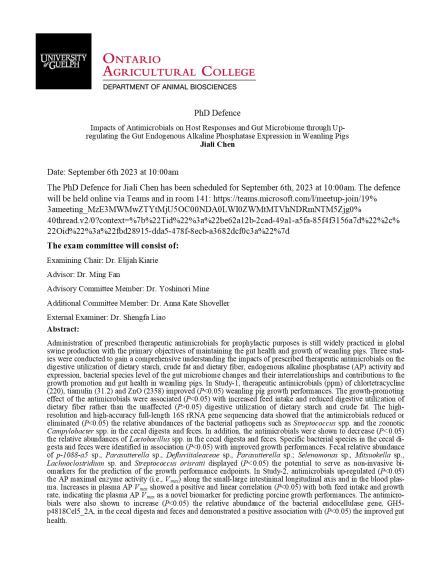Jiali Chen's PhD Defence
Date and Time
Location
Room 141 and Teams: https://teams.microsoft.com/l/meetup-join/19%3ameeting_MzE3MWMwZTYtMjU5OC00NDA0LWI0ZWMtMTVhNDRmNTM5Zjg0%40thread.v2/0?context=%7b%22Tid%22%3a%22be62a12b-2cad-49a1-a5fa-85f4f3156a7d%22%2c%22Oid%22%3a%22fbd28915-dda5-478f-8ecb-a3682dcf0c3a%22%7d

Details
Impacts of Antimicrobials on Host Responses and Gut Microbiome through Up-regulating the Gut Endogenous Alkaline Phosphatase Expression in Weanling Pigs
Administration of prescribed therapeutic antimicrobials for prophylactic purposes is still widely practiced in global swine production with the primary objectives of maintaining the gut health and growth of weanling pigs. Three stud-ies were conducted to gain a comprehensive understanding the impacts of prescribed therapeutic antimicrobials on the digestive utilization of dietary starch, crude fat and dietary fiber, endogenous alkaline phosphatase (AP) activity and expression, bacterial species level of the gut microbiome changes and their interrelationships and contributions to the growth promotion and gut health in weanling pigs. In Study-1, therapeutic antimicrobials (ppm) of chlortetracycline (220), tiamulin (31.2) and ZnO (2358) improved (P<0.05) weanling pig growth performances. The growth-promoting effect of the antimicrobials were associated (P<0.05) with increased feed intake and reduced digestive utilization of dietary fiber rather than the unaffected (P>0.05) digestive utilization of dietary starch and crude fat. The high-resolution and high-accuracy full-length 16S rRNA gene sequencing data showed that the antimicrobials reduced or eliminated (P<0.05) the relative abundances of the bacterial pathogens such as Streptococcus spp. and the zoonotic Campylobacter spp. in the cecal digesta and feces. In addition, the antimicrobials were shown to decrease (P<0.05) the relative abundances of Lactobacillus spp. in the cecal digesta and feces. Specific bacterial species in the cecal di-gesta and feces were identified in association (P<0.05) with improved growth performances. Fecal relative abundance of p-1088-a5 sp., Parasutterella sp., Defluviitaleaceae sp., Parasutterella sp.; Selenomonas sp., Mitsuokella sp., Lachnoclostridium sp. and Streptococcus orisratti displayed (P<0.05) the potential to serve as non-invasive bi-omarkers for the prediction of the growth performance endpoints. In Study-2, antimicrobials up-regulated (P<0.05) the AP maximal enzyme activity (i.e., Vmax) along the small-large intestininal longitudinal axis and in the blood plas-ma. Increases in plasma AP Vmax showed a positive and linear correlation (P<0.05) with both feed intake and growth rate, indicating the plasma AP Vmax as a novel biomarker for predicting porcine growth performances. The antimicro-bials were also shown to increase (P<0.05) the relative abundance of the bacterial endocellulase gene, GH5-p4818Cel5_2A, in the cecal digesta and feces and demonstrated a positive association with (P<0.05) the improved gut health.
Date: September 6th 2023 at 10:00am
Furthermore, specific bacterial species in the cecal digesta and feces were identified in association with the upregulation of the endogenous AP activity and improved gut health. Specifically, the fecal relative abundance of the bacterial species of Blautia obeum, Oribacterium sp., Lactobacillus salivarius, p-2534-18B5 sp., dgA-11 sp., Mucis-
pirillum sp. and Streptococcus orisratti exhibited a linear correlation (P< 0.05) with gut health, suggesting their po-
tential roles as biomarkers for predicting porcine gut health. In Study-3, antimicrobials down-regulated (P<0.05) the permeability and inflammation-related gene mRNA abundances in the hindgut which were also associated with
(P< 0.05) the growth performance and gut health endpoints as well as abundances of the identified specific bacterial species in the weanling pigs. Our findings provide insights into reducing the reliance on antimicrobials and in devel-
oping alternative strategies to antimicrobials in swine production